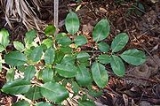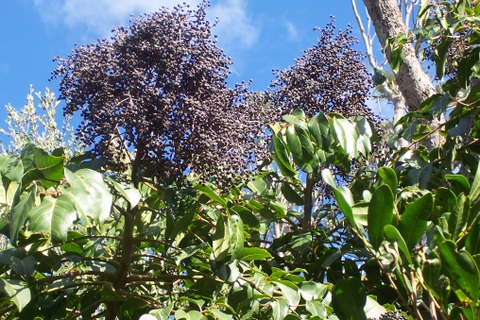
Polyscias elegans
Encyclopedia
Polyscias elegans, known as the Celery Wood is a rainforest tree of eastern Australia
. It occurs in a variety of different rainforest types; from fertile basaltic soils, to sand dunes and less fertile sedimentary soils. The range of natural distribution is from Jervis Bay
(35° S) in southern New South Wales
to Thursday Island (10° S), north of the Australian continent. Other common names include Black Pencil Cedar and Silver Basswood. Polyscias elegans is useful to bush regenerators as a nursery tree, which provides shade for longer lived young trees underneath.
Leaves are large, pinnate or bi-pinnate with almost opposite leaflets, often in threes. Leaflets ovate in shape, with a point, 5 to 13 cm long. Leaf veins noticeable on both sides, net veins visible below.
Purple flowers form on a terminal panicle
, arranged in a series of raceme
s in the months of February to April. However, flowers can form at other times. The fruit is a drupe
; brown or purplish black in colour, 5 to 7 mm wide. Inside the drupe are two cells, containing one seed each, 5 mm long. Seed is fertile for regeneration from the droppings of the Pied Currawong
.
Fruit eaten by a large variety of birds; including Brown Cuckoo Dove, Australasian Figbird
, Green Catbird
, Lewin's Honeyeater
, Olive-backed oriole
, Pied Currawong
, Paradise Riflebird
, Rose Crowned Fruit Dove, Silvereye
, Superb Fruit Dove, Topknot Pigeon
and Wompoo Fruit Dove.

Australia
Australia , officially the Commonwealth of Australia, is a country in the Southern Hemisphere comprising the mainland of the Australian continent, the island of Tasmania, and numerous smaller islands in the Indian and Pacific Oceans. It is the world's sixth-largest country by total area...
. It occurs in a variety of different rainforest types; from fertile basaltic soils, to sand dunes and less fertile sedimentary soils. The range of natural distribution is from Jervis Bay
Jervis Bay
Jervis Bay is a large bay bounded by the state of New South Wales, the Jervis Bay Territory, and a detached enclave of the Australian Capital Territory. HMAS Creswell is located between Jervis Bay Village and Greenpatch in the Jervis Bay Territory.-History:...
(35° S) in southern New South Wales
New South Wales
New South Wales is a state of :Australia, located in the east of the country. It is bordered by Queensland, Victoria and South Australia to the north, south and west respectively. To the east, the state is bordered by the Tasman Sea, which forms part of the Pacific Ocean. New South Wales...
to Thursday Island (10° S), north of the Australian continent. Other common names include Black Pencil Cedar and Silver Basswood. Polyscias elegans is useful to bush regenerators as a nursery tree, which provides shade for longer lived young trees underneath.
Description
A fast growing medium sized tree with an attractive palm like or umbrella shaped crown. Up to 30 metres tall and a trunk diameter of 75 cm. The trunk is mostly straight, unbuttressed and cylindrical. Smooth barked on young trees but fissured, scaly and rough barked on larger trees.Leaves are large, pinnate or bi-pinnate with almost opposite leaflets, often in threes. Leaflets ovate in shape, with a point, 5 to 13 cm long. Leaf veins noticeable on both sides, net veins visible below.
Purple flowers form on a terminal panicle
Panicle
A panicle is a compound raceme, a loose, much-branched indeterminate inflorescence with pedicellate flowers attached along the secondary branches; in other words, a branched cluster of flowers in which the branches are racemes....
, arranged in a series of raceme
Raceme
A raceme is a type of inflorescence that is unbranched and indeterminate and bears pedicellate flowers — flowers having short floral stalks called pedicels — along the axis. In botany, axis means a shoot, in this case one bearing the flowers. In a raceme, the oldest flowers are borne...
s in the months of February to April. However, flowers can form at other times. The fruit is a drupe
Drupe
In botany, a drupe is a fruit in which an outer fleshy part surrounds a shell of hardened endocarp with a seed inside. These fruits develop from a single carpel, and mostly from flowers with superior ovaries...
; brown or purplish black in colour, 5 to 7 mm wide. Inside the drupe are two cells, containing one seed each, 5 mm long. Seed is fertile for regeneration from the droppings of the Pied Currawong
Pied Currawong
The Pied Currawong is a medium-sized black passerine bird native to eastern Australia and Lord Howe Island. One of three currawong species in the genus Strepera, it is closely related to the butcherbirds and Australian Magpie of the family Artamidae. Six subspecies are recognised...
.
Fruit eaten by a large variety of birds; including Brown Cuckoo Dove, Australasian Figbird
Australasian Figbird
The Australasian Figbird is a conspicuous medium-sized passerine bird native to a wide range of wooded habitats in northern and eastern Australia, southern Papua New Guinea, and the Kai Islands in Indonesia. It was formerly considered a subspecies of S...
, Green Catbird
Green Catbird
The Green Catbird, Ailuroedus crassirostris is a species of bowerbird found on subtropical forests along the east coast of Australia, from southeastern Queensland to southern New South Wales. Its colouring is emerald green, with faint black markings on the face and white streaks on the neck.Green...
, Lewin's Honeyeater
Lewin's Honeyeater
The Lewin's Honeyeater, Meliphaga lewinii, is a bird that inhabits the ranges along the east coast of Australia. It has a semicircular ear patch, pale yellow in colour.The name of this bird commemorates the Australian artist John Lewin....
, Olive-backed oriole
Olive-backed Oriole
The Olive-backed Oriole is a very common medium-sized passerine bird native to northern and eastern Australia and New Guinea. The most wide-ranging of the Australasian orioles, it is noisy and conspicuous. Not bright in colour, it is olive-backed with small dark streaks, with a light chest having...
, Pied Currawong
Pied Currawong
The Pied Currawong is a medium-sized black passerine bird native to eastern Australia and Lord Howe Island. One of three currawong species in the genus Strepera, it is closely related to the butcherbirds and Australian Magpie of the family Artamidae. Six subspecies are recognised...
, Paradise Riflebird
Paradise Riflebird
The Paradise Riflebird, Ptiloris paradiseus, is a medium-sized, up to 30 cm long, passerine bird of the Paradisaeidae family. The male is black with an iridescent greenish blue crown, throat and central tail feathers. It has a black curved bill, black feet, dark brown iris and yellow mouth...
, Rose Crowned Fruit Dove, Silvereye
Silvereye
The Silvereye or Wax-eye is a very small passerine bird native to Australia, New Zealand and the south-west Pacific islands of Lord Howe, New Caledonia, Loyalty Islands, Vanuatu, and Fiji...
, Superb Fruit Dove, Topknot Pigeon
Topknot Pigeon
The Topknot Pigeon is a pigeon native to Australia. It is also known by the name of "Flock Pigeon".-Description:...
and Wompoo Fruit Dove.


